Australia
Australia is one of the developed countries that are faced with the problem of dwindling supplies of clean water as some of the reliable rivers become smaller in size than they were in the past (Dixon, 2015).
Residential
In residential areas, the government has come up with the following policies and strategic goals to reduce water wastage as a way of addressing the scarcity of this commodity:
- To reduce Melbourne residents’ rate of water consumption by 40% by 2020 through the use of improved showerheads, toilets, and taps (Melbourne Planning Scheme, 2013).
- The government has encouraged its citizens to avoid or minimize the use of traditional showers because of the massive amount of water that they require (Guerrini & Romano, 2014).
Agriculture
Agriculture is one of the main areas that consume a lot of water. The following best practices are embraced in the country to help address the water problem:
- Most farmers are using smart-landscaping as a means of maximizing water use on the farms by avoiding run-offs. Carbon Farming Initiative is proposed by the Department of Agriculture and Water Resources and the Emissions Reduction Fund to decrease greenhouse gas emissions. This approach is useful for areas with more than 600mm average annual rainfall. Since the agriculture sector of Australia counts for 18% of emissions, the contribution to water management is significant.
- Farmers are now embracing crops that require limited water and time to mature. It helps in reducing the pressure on farms (Dixon, 2015). Figure 1 below shows sources of water for the Australian agricultural sector:
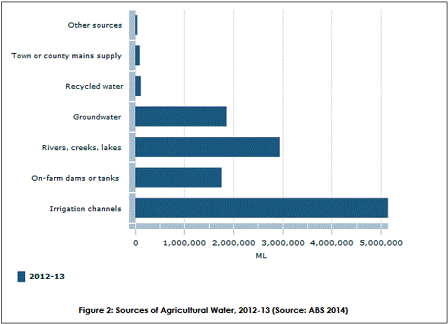
Non-Revenue
The government has introduced policies to minimize logging in the country to ensure that constant afforestation is not necessary (Washburn, 2013). The above is because planting new trees uses a significant amount of water.
California
The state of California is one of the areas in the United States where water is becoming a scarce resource. It is sometimes affected by flooding that destroys the state’s water infrastructure (Khare & Beckman, 2013).
Residential
The Los Angeles government has come up with various measures to ensure that water is used in the residential areas responsibly:
- Water in the residential areas is metered to ensure that the residents become more responsible in their use of water. It means that those who are tempted to use more water will have to pay larger water bills (Russ, 2018).
- Residential landscape architecture is also becoming common in California. As noted by the Environmental Protection Agency (EPA), remediation techniques, reuse of greywater, and drip irrigation may help to prevent $1.6 billion spent annually by using approximately nine billion gallons of water in terms of flooding (“Sustainable residential design,” 2018).
Agriculture
- Regulated deficit irrigation. The micro-spray system of irrigation is increasingly becoming popular in most of the farms in California. The system ensures that water is released to the specific place closest to the roots of the plant and in the required amounts (World Bank, 2013).
- Sprinkler and drip irrigation systems. Due to higher distribution uniformities, this system allows increasing water-use effectiveness.
- Weather-based irrigation is one of the practices becoming common in California. Farmers in the country are also embracing regulated deficit irrigation and drip irrigation to reduce water use. Figure 2 below shows reduced water use in the agricultural sector and urban settings within the state. The total water use reduction is approximately 10 million acre-feet in 2015 compared to 2005 when the population was significantly smaller.
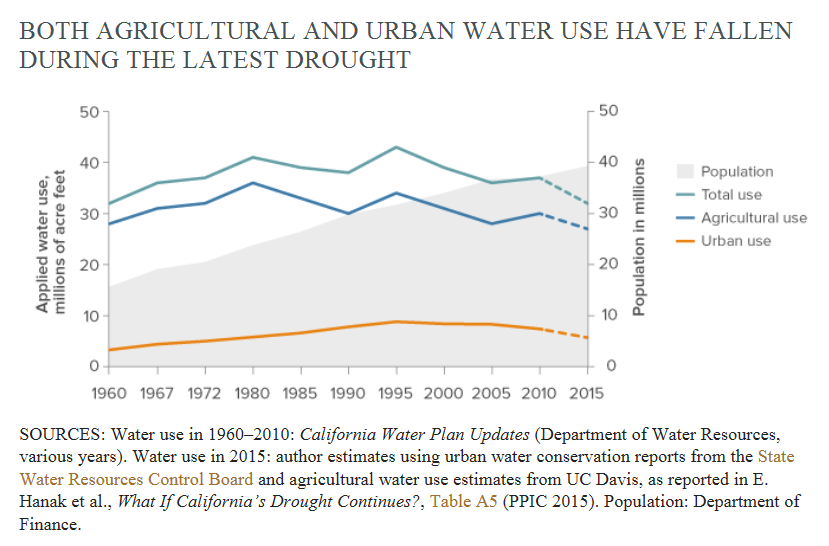
Non-Revenue
Most of the sporting stadiums for soccer are now embracing the artificial grass instead of natural grass for carpeting. Given that the artificial grass does not need watering, water use in these soccer stadiums is reduced by over 65%.
Arizona
The scarcity of water in Arizona is becoming a major concern, especially following the recent cases of prolonged drought (Chen, 2017).
Residential
- In the city of Phoenix, water rationing has become a common practice to help manage minimal water supplies (Malloy, 2013). The approach enables the residents to appreciate the value of the commodity and to use it responsibly.
- The city has one of the best response mechanisms in cases of water leakage to help reduce seepage loss in residential areas (Chanie, 2014).
Agriculture
- Tailwater re-use system. Most farmers in Arizona are encouraged to eliminate water loss that is caused by tail-water runoff through proper landscaping (Borchardt & Ibisch, 2013).
- Concrete-lined ditches and laser technology to grade land help to enhance the uniform application of water, reduce erosion, and minimize losses.
- Level basin irrigation and sprinkler irrigation reduce percolation and promote a decrease in the runoff.
- Drip or trickle irrigation, crop rotations, soil and water analysis, flow rate measurement, irrigation scheduling, and bed and furrow shaping allow gathering relevant information and ensure consistent irrigation.
- In the city of Phoenix, the use of LID and GI storm-water management techniques among farmers is encouraged (Phoenix City Council, 2013).
- The reduction of water use by agriculture is 21% that is caused by urbanization and investment in modern policies focused on conservation and irrigation.
Non-Revenue
In major public parks, irrigation of the grass and other plantation is done late in the evening. The strategy helps in minimizing water loss through irrigation. It ensures that these parks remain green but at the same time use a minimal amount of water possible.
Texas
According to Leal and Sümer (2015), one of the worst-hit areas in the United States with the problem of water scarcity in Texas.
Residential
- Houston City Council encourages its residents to minimize outdoor uses of water. The watering of lawns is encouraged at night and using mostly recycled water (see Figure 3).
- The state has also encouraged most of the garages to embrace laser wash technologies instead of the traditional water-based approach when cleaning the cars.
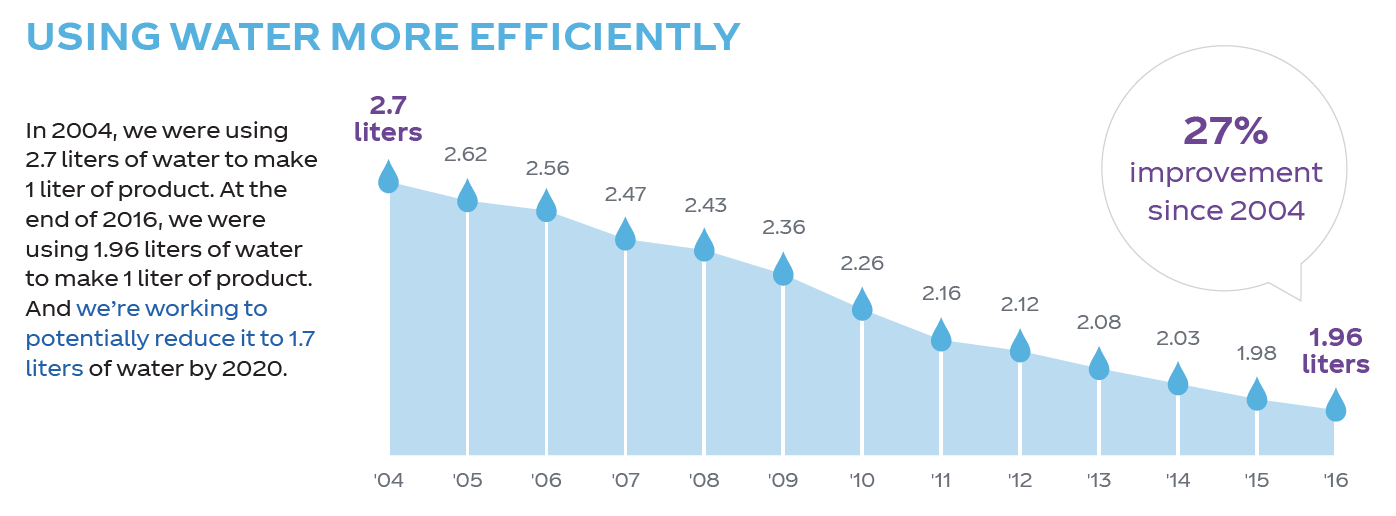
Agriculture
- Laser-assisted land leveling is becoming common in Texas. When using this technology, farmers are assured that unnecessary run-offs during irrigation are eliminated. It allows crops maximum time to absorb water (Balakrishnan, 2017).
- Farmers are also embracing technology-based schedules of irrigation to ensure that plants are watered at specific intervals and only when it is necessary (Mamitimin, 2016). Developing a pattern of irrigation also helps in eliminating the unnecessary and untimely release of water to plants.
Non-Revenue
The state has invested heavily in managing the sewerage system to ensure that clean water does not come in contact with clean water. If clean water is contaminated with sewerage water, it may lead to massive wastage of clean water that will be rendered unfit for human consumption. Avoiding such eventualities is critical.
Colorado
Colorado has experienced sporadic cases of prolonged drought. The overreliance on the local rivers such as the Colorado River means that clean water resources are becoming scarce (Setiawan, Kubota, & Nakagami, 2016). The strategies include the following.
Residential
- Denver City Council has come up with a strict water metering system to ensure that residents play a critical role in financing water that they use (Lorz, Makeschin, & Weiss, 2014). It discourages water wastage in the state.
- There is a system that ensures that there is regular inspection of the infrastructure to replace and repair areas of weakness. This proactive approach to managing the water infrastructure avoids possible water loss due to the constant breakage of the delivery pipes.
Agriculture
- The state is now encouraging its farmers to improve the ability of soil to manage moisture (Dore, 2015). That can be achieved through the proper use of specific fertilizers and avoiding sandy soils for farming.
- Some of the farmers are avoiding crops that take longer to mature because of the huge amount of water that is often required in the process. In the private sector, companies are keen on reducing the consumption of water. The figure below shows a reduction in water use at shale gas fraction within Colorado:
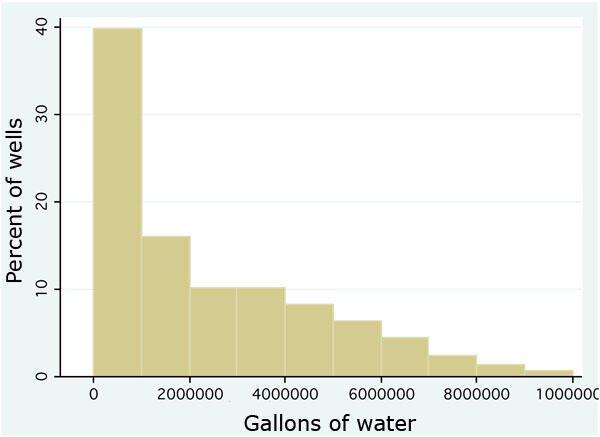
Non-Revenue
The Colorado government, working closely with scientists and other interested parties, has come up with new species of trees that require a minimal amount of water for growth. These trees are planted in public places such as along the streets and the parks. They are easy to maintain compared with some indigenous trees.
Singapore
Singapore has experienced massive economic development over the past three decades, but the scarcity of water is now becoming a major concern (Colombo, 2014).
Residential
The demand for clean water in residential areas, especially in major urban centers, has been growing because of population growth (Mishra, 2017). The following approaches have been embraced to enhance sustainable water use in Singapore City:
- In the city of Singapore, the practice of using hot towels to clean hands instead of water is becoming popular.
- One of the practices being encouraged in the country is limited toilet flushing (Gleick, 2014). According to the Sewerage and Drainage Act (SDA), all water should be discharged in sewage to be reused. Currently, Singapore’s desalinated water constitutes 25% of the total water supply. By 2060, it is expected to increase this indicator by 30% (“Singapore water story,” 2018). Figure 5 below shows how residents of Singapore are reducing their consumption of water.
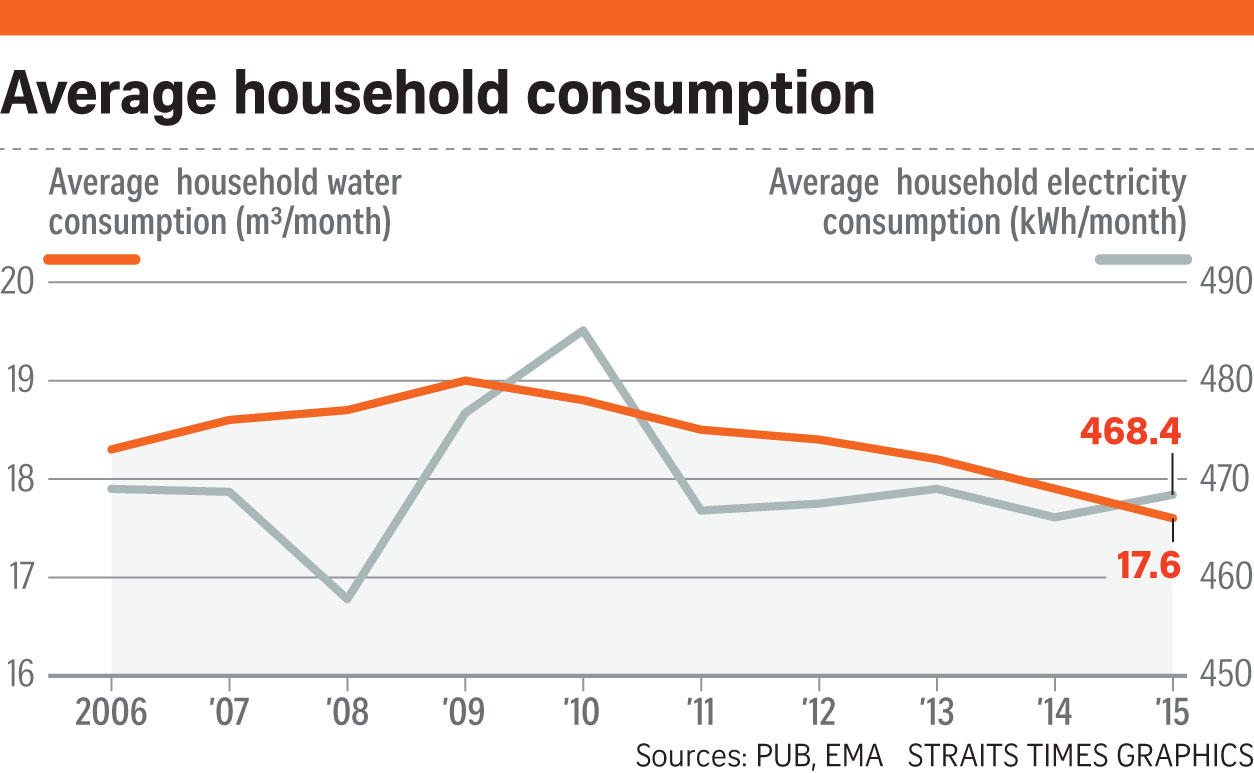
Agriculture
- Technology-based mechanization is becoming popular in the agricultural sector in Singapore (Morpeth & Hongliang, 2015). Unmanned aerial vehicles (UAVs) for irrigation, smog prevention, and monitoring.
- The Public Utility Board in Singapore “has pioneered a new technology known as ‘variable-Salinity plant’ (VSP) that enables processing facilities to process brackish rainwater collected in outlying catchment areas during the wet season and then shift to seawater desalination during the dry season according to variations in precipitation” (INSEAD, 2013, p. 3).
Non-Revenue
Cleaning of the streets and major markets in Singapore has been automated (Parris, 2016). The traditional water-based system is rapidly being replaced in major cities across the country with water-efficient machines that clean and disinfect using minimal amounts of water.
Canada
Canada is one of the world’s most water-secure countries, but the government and non-state actors have remained committed to ensuring that water is used responsibly (Younos & Parece, 2016).
Residential
Most Canadians are living in major urban centers across the country such as Toronto and Vancouver (Setegn & Donoso, 2015). In these cities and town, the following best practices in water use have been embraced:
- Many residential homes and hotels in Vancouver are now adopting water-saving plumbing systems in the washrooms. Water-efficient shower-heads and toilets are replacing the traditional ones that used a lot of water (Chanie, 2014).
- Canadians are also embracing water-efficient appliances at home such as washing machines that require less amount of water because of their enhanced technologies.
Agriculture
- Green infrastructure approaches to water management are becoming popular among Canadian farmers. They include the use of bio-retention ponds and bioswales to ensure that runoff water is harvested and stored for future farm use (Amery, 2015).
- Regular education and cooperation of farmers on effective water use in the farms have promoted best practices in water management in the country such as having large communal water harvesting complex during major rains (Kidd, Feris, Murombo, & Iza, 2014). The communal approach enables farmers to assist one another whenever it is necessary.
Non-Revenue
The Vancouver City Council has introduced systems and structures that help in watering public parks and vegetative cover within the city. The council has also come up with a lawn watering system that residents must observe. Under the policy, watering of a lawn is only allowed between the hours of 4 am-9 am, as a way of reducing water loss through evaporation (City of North Vancouver, 2017).
Italy
Italy is one of the European countries where water scarcity is becoming a concern, although the problem has not reached a crisis level (Kolokytha, Oishi, & Teegavarapu, 2016).
Residential
- In Italy, many homeowners are reducing excessive watering of the gardens. Most of these gardens are watered in the evening when the problem of water loss due to evaporation is at its lowest. It gives the grass and flowers ample time to absorb water before sunrise.
- According to Amery (2015), another common practice in many homes is the washing of cars on lawns to minimize the need to water grass. It means that when one is washing the car, the lawn will be watered in the process.
Agriculture
- The use of hydrogen-2 and oxygen-18 among other isotopes is becoming a popular water management principle in many Italian farms as a means of reducing demand for water in the agricultural sector (Lloyd, 2018).
- According to the City Council of Milan (2015), waste-water reuse in Italian agriculture is becoming popular. In the city of Milan, programs and policies of using participatory approaches water recycling are common.
Non-Revenue
In Italy, football is one of the most popular sports. San Siro in Milan is one of the largest and most advanced football stadiums in the world. The management of this stadium has embraced effective water management practices in cleaning and maintaining the stadium in good shape. The use of vacuum cleaners reduces the use of water in these stadiums by over 65% (Lloyd, 2018).
Malaysia
Malaysia is one of the Asian countries that have registered to improve the growth of the economy in the recent past. The growth of the economy in the country can only be sustainable if the water is made available at all times. The following are the strategies used to enhance that sustainability:
Residential
- In the major city of Kuala Lumpur, grey-water harvesting is becoming a popular practice. Water from the showers is often directed to the lawns to maximize its use (Lloyd, 2018).
- The government has been sponsoring promotional campaigns on water management principles such as the importance to identify and immediately address water leakages at home.
Agriculture
- According to Cahan (2017), a zoning system where farmers growing particular crops are located close to one another is common in Malaysia to help in ensuring that they can combine their effort to harvest runoff water and store it for future use. The system also makes it possible for farmers to work together in many other related activities.
- The practice of using greenhouses has become popular in Malaysia. Tomatoes, vegetables, and various fruits are now farmed by greenhouses because of the limited amount of water that is needed for agriculture (Gibson, 2013).
Non-Revenue
The government of Malaysia is using exotic trees that require limited water to improve vegetative cover in major urban centers.
Germany
Residential
- In the city of Munich, most homes and hotels have embraced emerging technologies in water use. The modern showers and toilets used in most homes and hotels use a minimal amount of water and are very efficient.
- According to the Federal Water Management Act (FWA), domestic water is properly piped to homes and hotels to avoid the use of water delivery trucks which are always less effective in transporting water from the source to the customers.
Agriculture
- The Water Framework Directive (WFD) regulates the agriculture sector as well. German farmers have embraced sophisticated technology in the farming sector. Farmers are now using an isotopic signature (nitrogen-15) to help them collect relevant data about the movement of water in the soil (Shahid & Ahmed, 2014). When using this technology, the watering of the plants is done only when it is determined to be necessary.
- Many German farmers are embracing a new water management system known as the cosmic-ray neutron probe (Shahid, 2013). The technology makes it possible to identify and assess possible water fluxes within farming areas to provide critical information on the best landscaping approach that the farm would require.
Non-Revenue
Water is also used in non-revenue activities within the country, especially in the sporting sector, and in maintaining cleanliness in major cities such as Munich and Berlin (Lassiter, 2015).
- All major football fields in Munich and Berlin are covered with synthetic grass. It is superior to the normal grass in terms of its texture and visual appeal. Most importantly, it only needs water for cleaning, not regular watering.
- According to Born (2018), Munich airport “with a total size of around 1,500 hectares, takes only 5.9% of the former marshes and moss area where it is located” (para. 6). The strategy reduces the demand for water in the maintenance of the airport.
- The total reduction of water use in Germany achieved 18% below 2000 levels.
References
Amery, H. (2015). Arab water security: Threats and opportunities in the Gulf States. Cambridge, England: Cambridge University.
Balakrishnan, M. (2017). UAE: Public policy perspectives. Dubai, UAE: Al Ghurair Group Publishers.
Borchardt, D., & Ibisch, R. (2013). Integrated water resources management in a changing world: Lessons learnt and innovative perspectives. London, England: IWA Publishing.
Born, C. (2018). Environmental protection and sustainability. Web.
Cahan, J. (2017). Water security in the Middle East: Essays in scientific and social cooperation. New York, NY: Anthem Press.
Chanie, P. (2014). Innovative water resource use and management for poverty reduction in Sub-Saharan Africa: An anthology. New York, NY: Cengage.
Chen, D. (2017). Sustainable water management and technologies. Boca Raton, FL: CRC Press.
City Council of Milan. (2015). Urban food policy framework for action. Web.
City of North Vancouver. (2017).Lawn watering regulations. Web.
The Coca Cola Company. (2016). Improving our water efficiency: Water stewardship and replenish report. Web.
Colombo, S. (2014). Bridging the gulf: EU-GCC relations at a crossroads. New York, NY: Cengage Learning.
Dixon, S. (2015). The science and engineering of sport surfaces. New York, NY: Routledge.
Dore, M. (2015). Global drinking water management and conservation: Optimal decision-making. Cham, Switzerland: Springer International Publishing.
Gibson, M. (2013). Environmental burden of disease assessment: A case study in the United Arab Emirates. New York, NY: Springer.
Gleick, P. (2014). The world’s water: The biennial report on freshwater resource. Washington, DC: Island Press.
Guerrini, A., & Romano, G. (2014). Water management in Italy: Governance, performance, and sustainability. New York, NY: Cengage.
INSEAD. (2013).Case study: Tackling Singapore’s water shortage. Web.
Jenkins, J. (2013). Energy facts: How much water does fracking for shale gas consume? Web.
Khare, A., & Beckman, T. (2013). Mitigating climate change: The emerging face of modern cities. Berlin, Germany: Springer.
Kidd, M., Feris, L., Murombo, T., & Iza, A. (2014). Water and the law: Toward sustainability. Cheltenham, UK: Edward Elgar.
Kolokytha, E., Oishi, S., & Teegavarapu, R. (2016). Sustainable water resources planning and management under climate change. Singapore: Springer.
Lassiter, A. (2015). Sustainable water: Challenges and solutions from California. Oakland, CA: University of California Press.
Leal, F., & Sümer, V. (2015). Sustainable water use and management: Examples of new approaches and perspectives. Cham, Switzerland: Springer.
Lehane, S. (2014).Australia’s water security part 2: Water use. Web.
Lloyd, O. (2018). Smart water technologies, and techniques: Data capture and analysis for sustainable water management. Hoboken, NJ: John Wiley & Sons.
Lorz, C., Makeschin, & Weiss, H. (2014). Integrated water resource management in Brazil. London, England: IWA Publishing.
Malloy, R. (2013). Urban development and sustainable water management of southwest cities. Hoboken, NJ: Wiley.
Mamitimin, Y. (2016). Role of irrigation water pricing in sustainable water resources management along the Tarim River, Northwest China. London, UK: Springer.
Melbourne Planning Scheme. (2013). Energy, water and waste efficiency. Web.
Mishra, A. (2017). Nanotechnology for sustainable water resources. Washington, DC: Wiley-Scrivener.
Morpeth, D., & Hongliang, Y. (2015). Planning for tourism: Towards a sustainable future. New York, NY: Cengage.
Mount, J., & Hanak, E. (2016). Water use in California. Web.
Parris, K. (2016). Ecology of urban environments. Hoboken, NJ: Wiley.
Phoenix City Council. (2013).City of Phoenix storm water policies and standards. Web.
Russ, M. (2018). Handbook of knowledge management for sustainable water systems. New York, NY: Cengage.
Setegn, G., & Donoso, C. (2015). Sustainability of integrated water resources management: Water governance, climate, and eco-hydrology. Hoboken, NJ: Wiley.
Setiawan, B., Kubota, J., & Nakagami, K. (2016). Sustainable water management: New perspectives, design, and practices. Singapore: Springer.
Shahid, S. (2013). Developments in soil classification, land use planning and policy implications: Innovative thinking of soil inventory for land use planning and management of land resources. London, England: Springer.
Shahid, S., & Ahmed, M. (2014). Environmental cost and face of agriculture in the Gulf Cooperation Council countries: Fostering agriculture in the context of climate change. New York, NY: Cengage.
Singapore water story. (2018). Web.
Sustainable residential design: Improving water management. (2018). Web.
Tan, A. (2016). Experts credit increased use of energy-efficient appliances, but say more needs to be done. Web.
Washburn, A. (2013). The nature of urban design: A New York perspective on resilience. Hoboken, NJ: Wiley.
World Bank. (2013). Renewable energy desalination: An emerging solution to close the water gap in the Middle East and North Africa. Washington, DC: World Bank.
Younos, T., & Parece, T. (2016). Sustainable water management in urban environments. Cham, Switzerland: Springer International Publishing.